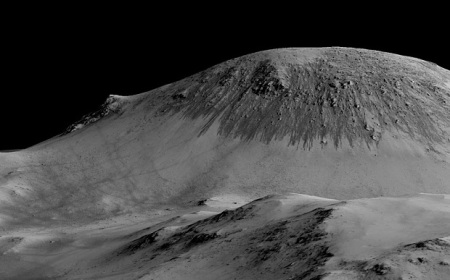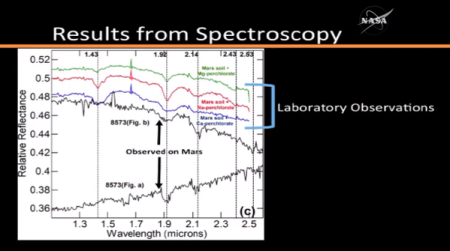Evidence for Liquid Water on Mars?
There’s been a lot of excitement this afternoon about possible evidence for water on Mars from the Compact Reconnaissance Imaging Spectrometer for Mars (CRISM) on board the Mars Reconaissance Orbiter (MRO). Unfortunately, but I suppose inevitably, some of the media coverage has been a bit over the top, presenting the results as if they were proof of liquid water flowing on the Red Planet’s surface; NASA itself has pushed this interpretation. I think the results are indeed very interesting – but not altogether surprising, and by no means proof of the existence of flows of liquid water. And although they may indeed provide evidence confirming that there is water on Mars, we knew that already (at least in the form of ice and water vapour).
The full results are reported in a paper in Nature Geoscience. The abstract reads:
Determining whether liquid water exists on the Martian surface is central to understanding the hydrologic cycle and potential for extant life on Mars. Recurring slope lineae, narrow streaks of low reflectance compared to the surrounding terrain, appear and grow incrementally in the downslope direction during warm seasons when temperatures reach about 250–300 K, a pattern consistent with the transient flow of a volatile species1, 2, 3. Brine flows (or seeps) have been proposed to explain the formation of recurring slope lineae1, 2, 3, yet no direct evidence for either liquid water or hydrated salts has been found4. Here we analyse spectral data from the Compact Reconnaissance Imaging Spectrometer for Mars instrument onboard the Mars Reconnaissance Orbiter from four different locations where recurring slope lineae are present. We find evidence for hydrated salts at all four locations in the seasons when recurring slope lineae are most extensive, which suggests that the source of hydration is recurring slope lineae activity. The hydrated salts most consistent with the spectral absorption features we detect are magnesium perchlorate, magnesium chlorate and sodium perchlorate. Our findings strongly support the hypothesis that recurring slope lineae form as a result of contemporary water activity on Mars.
Here’s a picture taken with the High Resolution Imaging Science Experiment (HIRISE) on MRO showing some of the recurring slope lineae (RSL):
You can see a wonderful gallery of other HIRISE images of other such features here.
The dark streaky stains in this and other examples are visually very suggestive of the possibility they were produced by flowing liquid. They also come and go with the Martian seasons, which suggests that they might involve something that melts in the summer and freezes in the winter. Putting these two facts together raises the quite reasonable question of whether, if that is indeed how they’re made, that liquid might be water.
What is new about the latest results that adds to the superb detail revealed by the HIRISE images – is that there is spectroscopic information that yields clues about the chemical composition of the stuff in the RSLs:
The black lines denote spectra that are taken at two different locations; the upper one has been interpreted as indicating the presence of some mixture of hydrated Calcium, Magnesium and Sodium Perchlorates (i.e. salts). I’m not a chemical spectroscopist so I don’t know whether other interpretations are possible, though I can’t say that I’m overwhelmingly convinced by the match between the data from laboratory specimens and that from Mars…
Anyway, if that is indeed what the spectroscopy indicates then the obvious conclusion is that there is water present, for without water there can be no hydrated salts. This water could have been absorbed from the atmospheric vapour or from the ice below the surface. The presence of salts would lowers the melting point of water ice, so this could explain how there could be some form of liquid flow at the sub-zero temperatures prevalent even in a Martian summer. It would not be pure running water, however, but an extremely concentrated salt solution, much saltier than sea water, probably in the form of a rather sticky brine. This brine might flow – or perhaps creep – down the sloping terrain (briefly) in the summer and then freeze. But nothing has actually been observed to flow in such a way. It seems to me – as a non-expert – that the features could be caused not by a flow of liquid, but by the disruption of the Martian surface, caused by melting and freezing, involving movement of solid material, or perhaps localized seeping. I’m not saying that it’s impossible that a flow of briny liquid is responsible for the features, just that I think it’s far from proven. But there’s no doubt that whatever is going on is fascinatingly complicated!
The last sentence of the abstract quoted above reads:
Our findings strongly support the hypothesis that recurring slope lineae form as a result of contemporary water activity on Mars.
I’m not sure about the “strongly support” but “contemporary water activity” is probably fair as it includes the possibilities I discussed above, but it does seem to have led quite a few people to jump to the conclusion that it means “flowing water”, which I don’t think it does. Am I wrong to be so sceptical? Let me know through the comments box!
Follow @telescoper


September 28, 2015 at 7:04 pm
That seems a very reasonable summary.
September 30, 2015 at 11:32 am
A sober voice in the midst of a lot of hype.
Not to take away anything from this finding, but any time it’s publicised by NASA or other agencies that they are announcing a mystery press conference, I get prepared to be more underwhelmed than average. Even more so since that Mono Lake thing: astrobiology’s BICEP2.